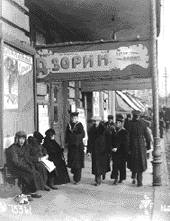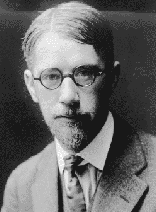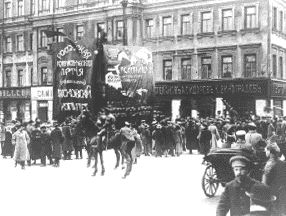American Film Propaganda in Revolutionary Russia
By James D. Startt
© 1998 by James D. Startt

|
A public movie house on Soetlanslaja Street in Vladivostok. (NARA, 111-SC-75361) |
To the truism that modern wars are fought with words as well as weapons must be added "images," especially moving picture images. Moreover, the fact that motion pictures were used as vehicles of propaganda in this century's world wars comes as no surprise. At the time of World War I, when propaganda in its modern forms came of age, film was leaping forward as a popular mass medium of entertainment and journalism. Films had appeared as vehicles of war journalism in the turn-of-the-century wars, but they were all limited conflicts.(1) World War I, by comparison, was a total war, and that made propaganda, in all of its possible forms, an imperative dimension of warfare.
During the war the American propaganda organization, the Committee on Public Information (CPI or Compub), conducted widespread operations abroad and in this country. Its international work, however, has attracted little scholarly notice.(2) The CPI carried on one of its most vigorous overseas campaigns in Russia, yet its activities in that vast land have been neglected by historians. As extensive records in the National Archives and elsewhere show, the CPI dispersed printed materials by the hundreds of thousands in Russia after the United States entered the war. Those records also show that the CPI made creative use of films in its Russian operation, but that part of its work has gone largely unheralded.(3) Its use of motion pictures, however, represents a fascinating effort to employ the film medium as an instrument of propaganda, and it is the purpose of this article to inquire into the why and how of its use and to consider the question of its significance. Since film was part of a multifaceted operation, an explanation of why the CPI became active in Russia is the logical starting point.
The Case for American Propaganda in Russia
From the beginning of the war, all the major belligerents created propaganda organizations to unify and mobilize their own populations and to influence those beyond their borders. As the war acquired a character of totality, the effort to control and influence civilian populations grew in importance, as did the need to inspire a nation's own fighting forces and to demoralize those of enemy countries. For these reasons, upon the entrance of the United States into the war in 1917, President Wilson ordered the formation of the Committee on Public Information and appointed George Creel, a liberal journalist and ardent Wilson supporter, to head it.
Creel called the CPI's work "a vast enterprise in salesmanship, the world's greatest adventure in advertising."(4) Any comprehensive study of its operations confirms the truth of that claim, for the CPI saturated this nation with its material and extended its foreign outreach across Europe, Latin America, and parts of Asia. Prevailing circumstances conditioned that work in all instances, but in Russia it faced the challenge of operating amid swirling currents of revolution. Just a month before the American entrance into the war, Russia experienced its first revolution of 1917 with the toppling of the tsarist regime. After months of maneuvering and confrontation by various forces within that country, a second revolution, the Bolshevik Revolution, occurred in October, establishing a Communist regime in Petrograd (St. Petersburg) and Moscow. The Bolsheviks, however, had to fight a two-and-a-half-year civil war to gain control of and spread their revolution across the remainder of the old imperial Russia. The revolutionary state of affairs in Russia had a great impact on all the major warring nations. They perceived the fate of Russia as crucial to their own hope for victory or fear of defeat. For this reason, both the Allied and Central Powers tried to influence and guide events and persuasions in Russia for the remainder of the war.
News of the end of the tsarist regime and the establishment of a Russian Republic headed by a Provisional Government on March 15, 1917, at first exhilarated the Western Allies. The United States, then drifting even closer to entering the war, greeted the fall of the tsarist autocracy as "a political upheaval in the old American spirit; republican, liberal, antimonarchial,"(5) and it became the first nation to extend official recognition to the new Russia. When the United States entered the war a month later, pressure mounted immediately for it to become involved in Russian affairs by means of economic or military assistance. Pressure also grew for the United States to inaugurate a publicity campaign in Russia.
At that time, the Allies thought the Americans might succeed where they had failed. As Russian morale deteriorated in February 1916, the British decided to initiate official propaganda in Petrograd under the direction of Hugh Walpole and Harold Williams and in Moscow under Bruce Lockhart. By June of 1917, however, they informed our State Department: "The United States is the best situated country from which to organize a counter-propaganda. The Germans have been able to make the Russian people somewhat suspicious of the aims of the French and English."(6) In fact, after the failure of the Gallipoli campaign (1915-1916) and the shock of the Irish Easter Uprising of 1916, Russian confidence in the British waned, thus allowing German and Russian antiwar propaganda more opportunity for exploitation.(7) Accordingly, the British believed the time had come for the introduction of American propaganda into Russia. The object was to mobilize an effective counter to German propaganda and to encourage the Russians to remain in the war. Another objective, the need to counter Bolshevik anti-American and anti-Allied propaganda, would be added later.
Although Secretary of State Robert Lansing was emphatic in agreeing with the British assessment, President Wilson wanted more information before acting and decided to send a goodwill mission to Russia.(8) Headed by the distinguished statesman Elihu Root, its purpose was to spur on the Russian war effort and to appraise the situation there. The mission's subsequent report urged the Wilson administration to wage a propaganda campaign in Russia. When George Creel analyzed the report for Wilson, he concluded that the work should be "done well and done quickly." He also recommended that the State Department should not be involved in the work as the report had suggested it was a job for the CPI.(9)

|
Arthur Bullard directed the CPI's Russian Division. (NARA, General Records of the Department of State, RG 59) |
American publicity operations, therefore, began in the summer of 1917 and lasted until March 1919. At first they were meager and makeshift, conducted as an adjunct assignment at our various diplomatic posts in Russia. They gained momentum in the fall of 1917, when the CPI was able to undertake its campaign there. Edgar Sisson headed its Russian organization at first, but throughout most of 1918, the main period of its activity, Arthur Bullard was in charge of the operation. He was a brilliant liberal journalist with previous experience in Russia, and he is central to any understanding of our publicity operation there. Bullard was a committed internationalist who admired President Wilson, sympathized with the cause of democracy in Russia, and believed in making democratic ideology a component of our propaganda in that troubled country.
Others agreed that ideology should be included in the campaign. In particular, Charles Edward Russell, a prominent member of the Root mission, made an influential case for appealing to the Russian democratic impulse. He went directly to the President about the matter. "The Russian army is now nothing but a reflex of the Russian people," he argued. "The trouble is that at the present the average Russian sees nothing in the war that appeals to the soul in him. The war was made by the Czar; that mere fact prejudices the average Russian against it." Neither did he believe that the typical Russian felt an obligation to the Allies or to the pledge made by the old regime to the Allies. The Russians, however, did acknowledge the "duty of a democrat to fight for democracy." "I write to beg therefore," Russell concluded, "that the education campaign carried on by this country in Russia be carefully directed along these lines. . . . [and addressed] to the Russian's passion for democracy." If the Russians could be convinced that their revolution was in peril, they would willingly continue to fight.(10) To this Wilson responded, "I deeply appreciate your letter. It runs along lines of my own thought, only you speak from knowledge and I have thought by inference, and you may be sure that I will do my best to act along the lines it suggests."(11) Commenting on Russell's appeal, Wilson told Creel, "Here is a very important letter which I wish you would read and inwardly digest. It seems to me to hit very near the heart of the subject it is concerned with."(12) The effort to keep Russia in the war and to counter German propaganda would now include an ideological component.
The Logic and Deployment of Film Propaganda
As our propaganda campaign in Russia got under way in the second half of 1917, the idea grew of making films an integral part of the operation. Some advocates of using motion pictures took their case to President Wilson. P. A. Strachen, who had been connected with various theatrical enterprises, prepared a ten-page memorandum on the subject for the President. "MOTION PICTURES, having become the medium of international expression and speaking a universal language, have in this instance, possibilities for extending the political power and prestige of the UNITED STATES OF AMERICA, at the same time acting as an educational and political guide to the millions of Russians, whose ideals, under their new form of democratic government, are as yet in the formative stage," he argued. "MOTION PICTURES can show these people the manifold advantage of a democratic government, particularizing on the progress made, along political and industrial lines." Strachan had in mind a "monster picture" composed of parts from existing relevant films to counter "Kaiser Wilhelm's plans for world domination" and to serve as an instrument for "visualizing American progress." A message from President Wilson to the Russian people could introduce the film, which would feature scenes of American cities, industries, resources, and military preparedness. The finale should be a cartoon of the United States and Russia together fighting "the hydra-headed monster, Prussianism" with the caption, "HANDS ACROSS THE SEA."(13) Strachan's spirited appeal did not stand alone.
When the Root mission returned, it also urged that film be used in conjunction with other instruments of propaganda. George Creel assessed the mission's report for Wilson, and he too recognized the potential of using motion pictures in Russia. Although he raised questions about most of the suggestions the report advanced regarding the means to use for propaganda in Russia, he advised Wilson that employing films for this purpose was a "proper and necessary activity."(14)
Some individual members of the mission also made the case for film propaganda to Wilson. Charles Edward Russell pushed for the use of film in his appeal to Wilson. Along with printed matters, he said that film "relating the struggle for democracy elsewhere, picturing the heroes of democracy and their sacrifices and leading up to the present struggle as the final battle in a long conflict" would be the most useful medium to employ.(15) Another member of the Root mission, John R. Mont, reported to Secretary Lansing: "The reason why we called particular attention to American films is the fact that the Russians themselves whom we consulted expressed to us the strong desire that large use be made of American films. They deem it very important that we acquaint the Russian civil and military population with American life and that we bring vividly before them America's part in this War and that we seek to assure them that America has identified herself with them in the great struggle."(16)
There was, of course, a convincing logic behind these appeals for using the film medium. Motion pictures were popular in Russia even before the war, and to a war-weary people and to combat troops they would be entertaining as well as instructional. They could be shown over and over again, and by rewriting captions they could be made fully intelligible to educated Russians. Moreover, films could overcome the high illiteracy rate in Russia and engage the masses by having speakers read the captions. Consequently, when the CPI began its operations in Russia in November 1917, films were prominent among the materials it publicized and distributed.
Working inside Russia could never be considered an easy task, but during the time of the CPI's operation, conditions tested the most determined of men. Its activities began at the very time of the Bolshevik Revolution and would be caught up in the awesome swings of the subsequent civil war. When the Provisional Government fell, no one knew if the Bolsheviks would even permit the operation. As Russia then tumbled deeper into revolution, Bullard wrote from Moscow that "any newspaper or oratorical or cinematic campaign intended to influence the course of events here in the next few months is like shooting arrows at a thunderstorm." It is interesting to note that even at this point Bullard had misgivings about propaganda aimed simply at keeping Russia in the war. "I have felt from the first," he said, "that all our propaganda . . . ought to be aimed at creating an impression of permanency. Constructing the basis for future friendship with Russia should be the focus of our efforts. The one great task for all who wish to make the world safe for democracy is to prevent a rapprochement between the imperialistically-minded. The diplomatic nightmare of the future is a new Dreikaiserbund--with perhaps a Mikado thrown in."(17) Regardless of exactly what the main focus of its operation might be, the CPI opened its Petrograd office in November 1917.

|
The Bolshevik Revolution of October 1917 led to a two-and-a-half-year civil war. A Bolshevik banner hangs at right. (NARA, 165-WW-157D-50) |
It began its work under the tight military control of the Bolsheviks' Red Guard.
But even under those circumstances, Edgar Sisson found it possible to begin
the publicity campaign, and Bullard was able to continue it after assuming command
when Sisson returned to the United States on March 4. In fact, during the winter
of 1917-1918, the CPI conducted its business without serious interference from
the Bolsheviks, even after they raided and closed down the British operation
late in December. The CPI made an extraordinary effort to circulate its printed
material during those winter months. It managed to distribute over three million
posters, handbills, and pamphlets publicizing Wilson's Fourteen Points message
of January 8.(18) No wonder that for this and other work through the printed
media President Wilson sent his "congratulations . . . on great work done splendidly."(19)
Film propaganda, however, was another matter.
American Film Propaganda
in Revolutionary Russia, Part 2
American Film Propaganda
in Revolutionary Russia, Part 3
| Articles published in Prologue do not necessarily represent the views of NARA or of any other agency of the United States Government. |